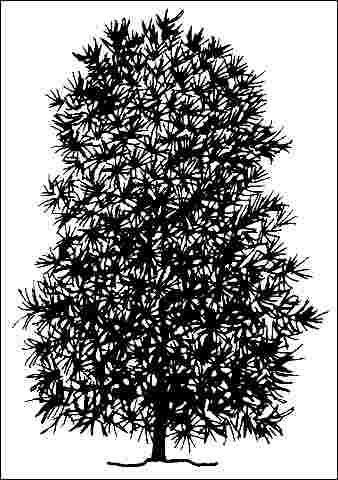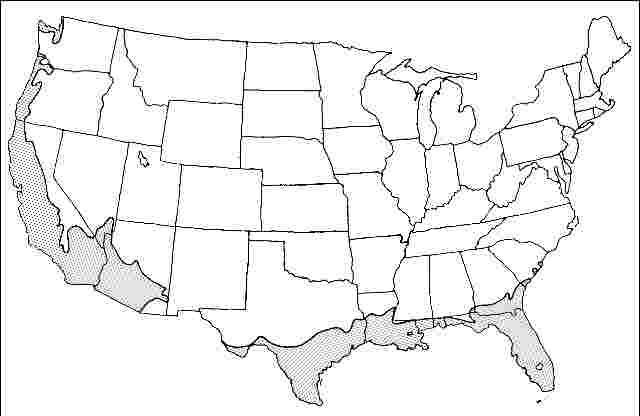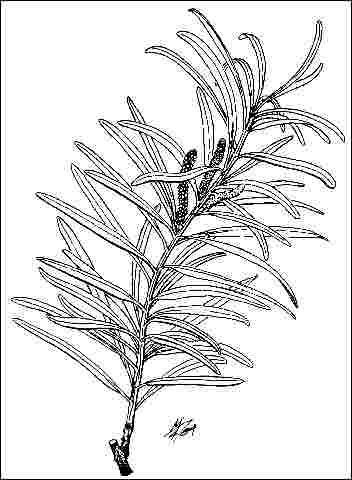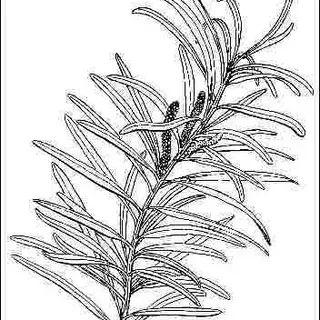Podocarpus macrophyllus: Podocarpus
Introduction
With densely foliated lower limbs which reach the ground, and neat, dark green, evergreen leaves, podocarpus is very popular as a dense screen or hedge. However, podocarpus can reach 35 to 50 feet in height when not sheared and is quite attractive as a tree with the lower branches removed, revealing the light brown, peeling bark. The crown of this columnar variety remains tight and does not open up like the species. It could be used in spaces where there is limited room for expansion of the crown. The inconspicuous flowers are followed by fleshy, purple, small, edible fruits (very good to eat) on female trees which are quite attractive to birds but not really messy on sidewalks or pavement. Leaves are recurved, unlike the straight leaves on the species.

Credit: UF/IFAS
General Information
Scientific name: Podocarpus macrophyllus
Pronunciation: poe-doe-KAR-pus mack-roe-FILL-us
Common name(s): Podocarpus
Family: Podocarpaceae
USDA hardiness zones: 7B through 11 (Figure 2)
Origin: not native to North America
Invasive potential: not considered a problem species at this time, may be recommended (North, Central, South)
Uses: highway median; screen; street without sidewalk; specimen; shade; espalier; hedge; reclamation; container or planter; deck or patio; parking lot island < 100 sq ft; parking lot island 100–200 sq ft; parking lot island > 200 sq ft; sidewalk cutout (tree pit); tree lawn 3–4 feet wide; tree lawn 4–6 feet wide; tree lawn > 6 ft wide; urban tolerant; indoors
Availability: not native to North America

Credit: UF/IFAS
Description
Height: 35 to 40 feet
Spread: 10 to 15 feet
Crown uniformity: symmetrical
Crown shape: round
Crown density: dense
Growth rate: slow
Texture: fine
Foliage
Leaf arrangement: opposite/subopposite (Figure 3)
Leaf type: simple
Leaf margin: entire
Leaf shape: linear
Leaf venation: parallel
Leaf type and persistence: evergreen
Leaf blade length: less than 2 inches, 2 to 4 inches
Leaf color: green
Fall color: no color change
Fall characteristic: not showy

Credit: UF/IFAS
Flower
Flower color: yellow
Flower characteristics: not showy
Fruit
Fruit shape: irregular, round, oval
Fruit length: .5 to 1 inch
Fruit covering: fleshy
Fruit color: purple
Fruit characteristics: attracts birds; not showy; fruit/leaves not a litter problem
Trunk and Branches
Trunk/bark/branches: branches don't droop; not showy; typically one trunk; thorns
Pruning requirement: little required
Breakage: resistant
Current year twig color: green
Current year twig thickness: medium, thick
Wood specific gravity: unknown
Culture
Light requirement: full sun, partial sun or partial shade, shade tolerant
Soil tolerances: clay; sand; loam; alkaline; acidic; well-drained
Drought tolerance: high
Aerosol salt tolerance: high
Other
Roots: not a problem
Winter interest: no
Outstanding tree: no
Ozone sensitivity: unknown
Verticillium wilt susceptibility: unknown
Pest resistance: resistant to pests/diseases
Use and Management
This is one of a few trees which can be pruned into a nice hedge. The dark green foliage and dense growth creates a formal mass. It looks better when pruned with a hand pruner, not sheared with a hedge trimmer.
Showing best growth and form in full sun, podocarpus will grow more slowly and have a looser appearance when grown in shade. It will grow on the north side of a tall building with little or no direct sun. It will tolerate a wide variety of well-drained, acidic soils. Don't plant on wet soils. This is a tough tree, adaptable to urban conditions and should be used much more extensively as a street tree. It should be used more in areas of poor soils and restricted rooting space. Unfortunately, most people choose to trim the tree into a column or hedge, so not many have seen the true beauty of the tree. It will make an attractive specimen, street or parking lot tree, even for the smallest soil space in a downtown planting pit. Roots are not a problem in restricted-soil planting areas and usually do not lift sidewalks.
Many varieties are available for selection of habit, leaf form, color, etc. Podocarpus macrophyllus var. appressus is a low shrub with short leaves; Podocarpus macrophyllus var. maki has erect branches, columnar form, 1.5- to 3-inch-long leaves.
Propagation is by seeds or cuttings. Hardwood cuttings root easily. Cutting propagation would ensure more uniform trees than seedlings. Nursery operators should be encouraged to grow podocarpus in the single-trunked tree form for planting in urban landscapes.
Pests and Diseases
Occasionally bothered by scale, mites, and sooty mold but not seriously. Some magnesium-deficiency on sandy soil, which is easily corrected with magnesium sulfate.



